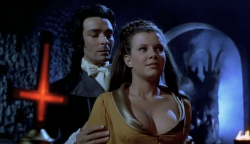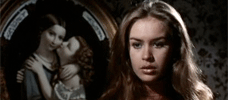Reviews
Jimmy Sangster
UK, 1971
Credits
Review by Leo Goldsmith
Posted on 16 February 2011
Source Anchor Bay DVD
Categories Lesbian Vampires
The series of loosely associated films known as the Karnstein Trilogy represents Hammer Films’ strident foray into the domain of the lesbian vampire, a subgenre-defining moment that launched the company from an increasingly musty set of genre franchises into one of the defining producers of exploitation cinema of the 1970s. Based with incrementally increasing artistic license on Sheridan Le Fanu’s highly influential 1872 novella, Carmilla, the films of the trilogy - The Vampire Lovers, Lust for a Vampire, and Twins of Evil - represent the libidinous core of the lesbian vampire subgenre, scripted by Danger: Diabolik and Barbarella contributor (and, later, important trade-unionist) Tudor Gates and boasting a seemingly interminable lineage of blood-thirsty, polyamorous nymphs. Over the next three days, join us as we studiously trace the genealogy of the Karnstein family.
Following the somewhat tongue-in-cheek literary pretensions of The Vampire Lovers, it would seem to make perfect sense that Lust for a Vampire should take place in an institution of learning. Its predecessor in Hammer’s Karnstein Trilogy - if “trilogy” one can call it - ingenuously avowed its commitment to literature by faithfully rendering Le Fanu’s classic tale in all its breast-biting beatitude; the follow-up continues this devotion to intellectual pursuits by setting its events in a school.
Okay, so it’s an all-girl school, but then this largely homosocial female domain is the only other consistent feature in an otherwise rather provisionally arranged “series.” For while Lust for a Vampire credits Le Fanu for the characters, returning screenwriter Tudor Gates dishes a completely different sort of narrative of sapphic succubi and heaving bosoms, now featuring a completely different and much younger Carmilla, played by archetypal Danish beauty Yutte Stensgaard. And whereas The Vampire Lovers, under the direction of the decidedly old-school Roy Ward Baker, was played totally straight - uh, that is, in earnest - Lust for a Vampire is considerably cheekier, with naughty double entendres and even more preposterous pretexts for casual, quasi-accidental nudity. Compared to its forebear, it’s a totally self-aware excursion into kitsch, a swinging lesbian vampire film for the free love era.
Lust for a Vampire is the type of film in which women will give each other back rubs before bedtime and go on late-night skinny-dipping excursions behind the backs of their prudish and disapproving mistress, Miss Playfair. But for all this, the film is surprisingly conservative, even traditional, in its configuration of gender roles. Unlike The Vampire Lovers, which stopped just short of making Carmilla its tortured hero, the purportedly more liberated sequel goes for the dashing male lead. It is the mid-19th century - once again - and Richard LeStrange, a “famous writer” with terrific sideburns, has arrived in the mountains of Styria by way (apparently) of Carnaby Street. When he learns that local village maidens are - once again - being abducted by vampires from the dreaded, deserted Karnstein Castle nearby, the dubious LeStrange creeps over to have a look and finds… a small private academy for buxom, diaphanously dressed, and not-yet-wayward girls.
Among the students enrolled in the school, which lies on the site of Karnstein Castle, is a blank-eyed, sweet-faced blonde named “Mircalla” (again, with the anagrams), whom LeStrange immediately falls for. Little does he realize that she is in fact a treacherous, blood-thirsty lesbian vampire, but curiously, the audience is apparently not supposed to know this either. Even if we’re as bad at anagrams as everyone else in the film, it ought to be fairly clear - not only from her lesbian licentiousness, but also from the fact that she’s always hanging out with beautiful girls who mysteriously die - that Mircalla is a bad girl, and yet the film pretends that this is some kind of mystery for LeStrange to solve. Spoiler warning: it turns out that Mircalla is Carmilla. Sorry.
Even if this lame narrative drive only barely propels the film forward, there’s plenty else besides, especially the On the Buses-style quips and leers. Even the sacrosanct avatars of higher education are not immune to brazen lampooning and dirty jokes—LeStrange himself exploits his position as a renowned writer to obtain a teaching position at the school, and with arched eyebrow tells me Mircalla, “Your education seems to have been neglected…. You’ll have to have some personal tuition.” Most fun of all is the oily, sniveling schoolmaster Giles Barton, played by regular Hammer creep Ralph Bates, who turns out to be a wonderfully obsequious satanist.
Unfortunately, once Mircalla/Carmilla drains Barton of his precious bodily essence, the film too loses much of its juice. The remainder of the film consists largely of LeStrange trying to solve the “mystery” of the identity of the vampire while routinely professing his love for Carmilla until, in one baffling scene, he actually beds down with her. He completes this tryst completely unscathed and unbitten, but no viewer will live through this experience without suffering the horrific strains of a dreadfully woozy pop song called “Strange Love.”
More like “Confusing Love”: it’s only a matter of time before Carmilla is back to her usual tricks, and the idea that she would be temporarily re-routed into the throes of heteronormative romance by LeStrange’s sideburns is never made fully convincing. It’s a genuinely frustrating and disappointing moment for a lesbian vampire: you really just want her to quickly sink her teeth into LeStrange and go after Miss Playfair, and yet the film keeps pushing to reform her, trying to lead her onto an all-too-straight and narrow path. So much for free love.
More Lesbian Vampires
-

Rape of the Vampire
1968 -

The Vampire Lovers
1970 -

Lust for a Vampire
1971 -

Twins of Evil
1971 -

Vampyros Lesbos
1971 -

Daughters of Darkness
1971 -

The Blood Spattered Bride
1972 -

Vampyres
1974
We don’t do comments anymore, but you may contact us here or find us on Twitter or Facebook.



